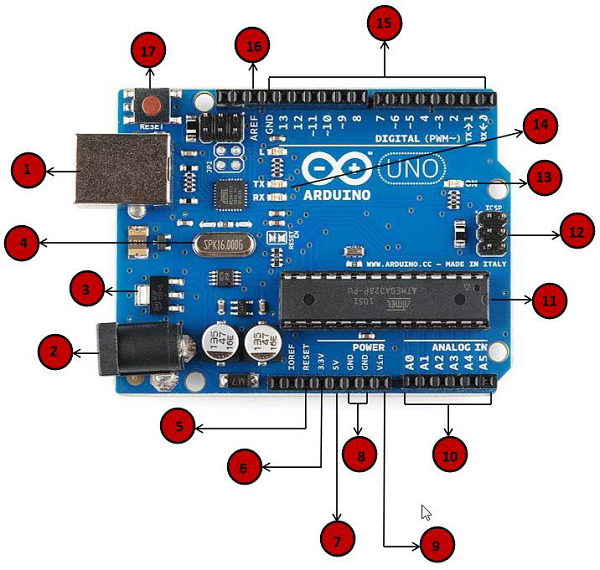- 描述 (1)
- arduino (1)
- Arduino盾(1)
- Arduino库
- Arduino库(1)
- Arduino盾
- arduino 和 (1)
- 元描述 - Html (1)
- 在 sql 中描述表(1)
- 描述 - 任何代码示例
- 元描述 - Html 代码示例
- 描述表mysql(1)
- 在 sql 代码示例中描述表
- Arduino函数
- Arduino-函数
- Arduino函数(1)
- Arduino-函数(1)
- Arduino字符串(1)
- Arduino-字符串(1)
- Arduino-字符串
- Arduino字符串
- 描述表mysql代码示例
- arduino 和 - 任何代码示例
- arduino - 任何代码示例
- Arduino-安装(1)
- Arduino-安装
- 描述列表 html (1)
- PostgreSQL描述表
- PostgreSQL - 描述表
📅 最后修改于: 2020-11-05 03:24:16 🧑 作者: Mango
在本章中,我们将学习Arduino板上的不同组件。我们将研究Arduino UNO板,因为它是Arduino板家族中最受欢迎的板。此外,它是入门电子和编码的最佳板。有些开发板看起来与下面给出的开发板有些不同,但是大多数Arduino在这些组件中大多数都是相同的。

 |
Power USB Arduino board can be powered by using the USB cable from your computer. All you need to do is connect the USB cable to the USB connection (1). |
 |
Power (Barrel Jack) Arduino boards can be powered directly from the AC mains power supply by connecting it to the Barrel Jack (2). |
 |
Voltage Regulator The function of the voltage regulator is to control the voltage given to the Arduino board and stabilize the DC voltages used by the processor and other elements. |
 |
Crystal Oscillator The crystal oscillator helps Arduino in dealing with time issues. How does Arduino calculate time? The answer is, by using the crystal oscillator. The number printed on top of the Arduino crystal is 16.000H9H. It tells us that the frequency is 16,000,000 Hertz or 16 MHz. |
 |
Arduino Reset You can reset your Arduino board, i.e., start your program from the beginning. You can reset the UNO board in two ways. First, by using the reset button (17) on the board. Second, you can connect an external reset button to the Arduino pin labelled RESET (5). |
 |
Pins (3.3, 5, GND, Vin)
|
 |
Analog pins The Arduino UNO board has six analog input pins A0 through A5. These pins can read the signal from an analog sensor like the humidity sensor or temperature sensor and convert it into a digital value that can be read by the microprocessor. |
 |
Main microcontroller Each Arduino board has its own microcontroller (11). You can assume it as the brain of your board. The main IC (integrated circuit) on the Arduino is slightly different from board to board. The microcontrollers are usually of the ATMEL Company. You must know what IC your board has before loading up a new program from the Arduino IDE. This information is available on the top of the IC. For more details about the IC construction and functions, you can refer to the data sheet. |
 |
ICSP pin Mostly, ICSP (12) is an AVR, a tiny programming header for the Arduino consisting of MOSI, MISO, SCK, RESET, VCC, and GND. It is often referred to as an SPI (Serial Peripheral Interface), which could be considered as an “expansion” of the output. Actually, you are slaving the output device to the master of the SPI bus. |
 |
Power LED indicator This LED should light up when you plug your Arduino into a power source to indicate that your board is powered up correctly. If this light does not turn on, then there is something wrong with the connection. |
 |
TX and RX LEDs On your board, you will find two labels: TX (transmit) and RX (receive). They appear in two places on the Arduino UNO board. First, at the digital pins 0 and 1, to indicate the pins responsible for serial communication. Second, the TX and RX led (13). The TX led flashes with different speed while sending the serial data. The speed of flashing depends on the baud rate used by the board. RX flashes during the receiving process. |
 |
Digital I/O The Arduino UNO board has 14 digital I/O pins (15) (of which 6 provide PWM (Pulse Width Modulation) output. These pins can be configured to work as input digital pins to read logic values (0 or 1) or as digital output pins to drive different modules like LEDs, relays, etc. The pins labeled “~” can be used to generate PWM. |
 |
AREF AREF stands for Analog Reference. It is sometimes, used to set an external reference voltage (between 0 and 5 Volts) as the upper limit for the analog input pins. |